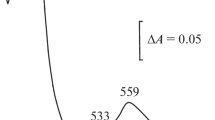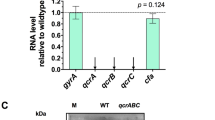Abstract
The susceptibility to dissimilatory reduction of polynuclear oxo- and hydroxo-bridged Fe(III) complexes byShewanella putrefaciens intact cells and membranes has been investigated. These complexes were ligated by the potential tetradentates heidi (H3heidi =N-(2-hydroxyethyl)iminodiacetic acid) or nta (H3nta = nitrilotriacetic acid), or the potential tridentate ida (H2ida = iminodiacetic acid). A number of defined small complexes with varied nuclearity and solubility properties were employed, as well as undefined species prepared by mixing different molar ratios of ida or heidi:Fe(III) in solution. The rates of Fe(III) reduction determined by an assay for Fe(II) formation with ferrozine were validated by monitoringc-type cytochrome oxidation and re-reduction associated with electron transport. For the undefined Fe(III) polymeric species, reduction rates in whole cells and membranes were considerably faster in the presence of heidi compared to ida. This is believed to result from generally smaller and more reactive clusters forming with heidi as a consequence of the alkoxo function of this ligand being able to bridge between Fe(III) nuclei, with access to an Fe(III) reductase located at the cytoplasmic membrane being of some importance. The increases in reduction rates of the undefined ida species with Fe(III) using membranes relative to whole cells reinforce such a view. Using soluble synthetic Fe(III) clusters, slow reduction was noted for an oxo-bridged dimer coordinatively saturated with ida and featuring unligated carboxylates. This suggests that sterically hindering the cation can influence enzyme action. A heidi dimer and a heidi multimer (17 or 19 Fe(III) nuclei), which are both of poor solubility, were found to be reduced by whole cells, but dissimilation rates increased markedly using membranes. These data suggest that Fe(III) reductase activity may be located at both the outer membrane and the cytoplasmic membrane ofS. putrefaciens. Slower reduction of the heidi multimer relative to the heidi dimer reflects the presence of a central hydroxo(oxo)-bridged core containing nine Fe(III) nuclei within the former cluster. This unit is a poor substrate for dissimilation, owing to the fact that the Fe(III) is not ligated by aminocarboxylate. The faster reduction noted for the heidi dimer in membranes than for a soluble ida monomer suggests that the presence of ligating water molecules may relieve steric hindrance to enzyme attack. Furthermore, reduction of an insoluble oxo-bridged nta dimer featuring ligating water molecules in intact cells was faster than that of a soluble monomer coordinatively saturated by nta and possessing an unligated carboxylate. This suggests that steric factors may override solubility considerations with respect to the susceptibility to reduction of certain Fe(III) complexes by the bacterium.
Similar content being viewed by others
References
Arnold RG, DiChristina TJ, Hoffman MR. 1986a Inhibitor studies of dissimilative Fe(III) reduction byPseudomonas sp. strain 200 (‘Pseudomonas ferrireductans’).Appl Environ Microbiol 52, 281–289.
Arnold RG, Olson TM, Hoffman MR. 1986b Kinetics and mechanism of dissimilative Fe(III) reduction byPseudomonas sp. 200.Biotechnol Bioeng 28, 1657–1671.
Arnold RG, DiChristina TJ, Hoffman MR. 1988 Reductive dissolution of Fe(III) oxides byPseudomonas sp. strain 200 (‘Pseudomonas ferrireductans’).Biotechnol Bioeng 32, 1081–1096.
Brettar I, Hofle MG. 1993 Nitrous oxide producing heterotrophic bacteria from the water column of the central Baltic: abundance and molecular identification.Mar Ecol Prog Ser 94, 253–265.
Clegg W, Powell AK, Ware MJ. 1984 Structure of trisodium bis(nitrilotriacetato)ferrate(III) pentahydrate. Na3[Fe{N(CH2-CO2)3 2]-5H2O}.Acta Cryslallogr C40, 1822–1824.
DiChristina TJ. 1992 Effects of nitrate and nitrite on dissimilatory iron reduction byShewanella putrefaciens 200.J Bacteriol 174, 1891–1896.
DiChristina TJ,, Arnold RG, Lidstrom ME, Hoffman MR. 1988 Dissimilative iron reduction by the marine eubacteriumAlteromonas putrefaciens strain 200.Water Sci Technol 20, 69–79.
Dobbin PS, Powell AK, McEwan AG, Richardson DJ. 1995 The influence of chelating agents upon the dissimilatory reduction of Fe(III) byShewanella putrefaciens.BioMetals 8, 163–173.
Gram L. 1994 Siderophore-mediated iron sequestering byShewanella putrefaciens.Appl Environ Microbiol 60, 2132–2136.
Harding CJ, Henderson RK, Powell AK. 1993 A new type of hexanuclear iron(III) hydroxo(oxo) cluster.Angew Chem Int Ed Engl 32, 570–572.
Heath SL, Powell AK. 1992 The trapping of iron hydroxide units by the ligand ‘heidi’: two new hydroxo(oxo)iron clusters containing 19 and 17 iron atoms.Angew Chem Int Ed Engl 31, 191–193.
Heath SL, Powell AK, Utting HL, Helliwell M. 1992 Crystal and molecular structure of a newμ-oxo-bridged iron(III) dimer formed with the nitrilotriacetate ligand.J Chem Soc, Dalton Trans, 305–307.
Henderson RK. 1994 The formation and structures of iron(III) polycarboxylato species formed in aqueous solutions.PhD thesis, University of East Anglia.
Hider RC. 1984 Siderophore mediated absorption of iron.Struct Bonding (Berlin) 58, 25–87.
Hider RC, Hall AD, 1991. Clinically useful chelators of tripositive elements. In: Ellis GP, West GB, eds.Progress in Medicinal Chemistry 28. Amsterdam: Elsevier; 40–173.
Lovley DR. 1991 Dissimilatory Fe(III) and Mn(IV) reduction.Microbiol Rev 55, 259–287.
Lovley DR. 1993 Dissimilatory metal reduction.Annu Rev Microbiol 47, 263–290.
Lovley DR. 1995 Microbial reduction of iron, manganese, and other metals.Adv Agron 54, 175–231.
Lovley DR, Phillips EJP, Lonergan DJ. 1989 Hydrogen and formate oxidation coupled to dissimilatory reduction of iron or manganese byAlteromonas putrefaciens.Appl Environ Microbiol 55, 700–706.
Martell AE, Smith RM. 1974Critical Stability Constants, Vol. 1. Amino Acids. New York: Plenum.
Myers CR, Myers JM. 1992 Localization of cytochromes to the outer membrane of anaerobically grownShewanella putrefaciens MR-1.J Bacteriol 174, 3429–3438.
Myers CR, Myers JM. 1993a Ferric reductase is associated with the membranes of anaerobically grownShewanella putrefaciens MR-1.FEMS Microbiol Lett 108, 15–22.
Myers CR, Myers JM. 1993b Role of menaquinone in the reduction of fumarate, nitrate, iron(III) and manganese(IV) byShewanella putrefaciens MR-1.FEMS Microbiol Lett 114, 215–222.
Myers CR, Nelson KH. 1988 Bacterial manganese reduction and growth with manganese oxide as the sole electron acceptor.Science 240, 1319–1321.
Myers CR, Nealson KH. 1990 Respiration-linked proton translocation coupled to anaerobic reduction of manganese(IV) and Fe(III) inShewanella putrefaciens MR-1.J Bacteriol 172, 6232–6238.
Nealson KH, Saffarini D. 1994 Iron and manganese in anaerobic respiration: environmental significance, physiology and regulation.Annu Rev Microbiol 48, 311–343.
Obuekwe CO, Westlake DWS, Cook FD. 1981 Effect of nitrate on reduction of ferric iron by a bacterium isolated from crude oil.Can J Microbiol 27, 692–697.
Obuekwe CO, Westlake DWS. 1982 Effects of medium composition on cell pigmentation, cytochrome content, and ferric iron reduction in aPseudomonas sp. isolated from crude oil.Can J Microbiol 28, 989–992.
Powell AK. 1993 Models for iron biomolecules. In: Silver J, ed.Chemistry of Iron. Glasgow: Blackie; 244–274.
Powell AK, Heath SL. 1994 Polyiron(III) oxyhydroxide clusters: the role of iron(III) hydrolysis and mineralization in nature.Comments Inorg Chem 15, 255–296.
Powell AK, Heath SL, Gatteschi Det al. 1995 Synthesis, structures and magnetic properties of Fe2, Fe17, and Fe19 oxo-bridged iron clusters: the stabilization of high ground state spins by cluster aggregates.J Am Chem Soc 117, 2491–2502.
Saffarini DA, Nealson KH. 1993 Sequence and genetic characterization ofetrA, anfnr analog that regulates anaerobic respiration inShewanella putrefaciens MR-1.J Bacteriol 175, 7938–7944.
Shweky I, Bino A, Goldberg DP, Lippard SJ. 1994 Syntheses, structures, and magnetic properties of two dinuclear iron(III) citrate complexes.Inorg Chem 33, 5161–5162.
Tsapin AI, Burbaev DS, Nealson KH, Keppen OI. 1994 Studies of the iron-sulphur centers ofShewanella putrefaciens (MR-1).Appl Magn Reson 7, 559–566.
Author information
Authors and Affiliations
Additional information
Previous paper in this series: Dobbin PS, Powell AK, McEwan AG, Richardson DJ. 1995 The influence of chelating agents upon the dissimilatory reduction of Fe(III) byShewanella putefraciens.BioMetals 8, 163–173.
Rights and permissions
About this article
Cite this article
Dobbin, P.S., Burmeister, L.M.R., Heath, S.L. et al. The influence of chelating agents upon the dissimilatory reduction of Fe(III) byShewanella putrefaciens. Part 2. Oxo-and hydroxo-bridged polynuclear Fe(III) complexes. Biometals 9, 291–301 (1996). https://doi.org/10.1007/BF00817930
Received:
Accepted:
Issue Date:
DOI: https://doi.org/10.1007/BF00817930




